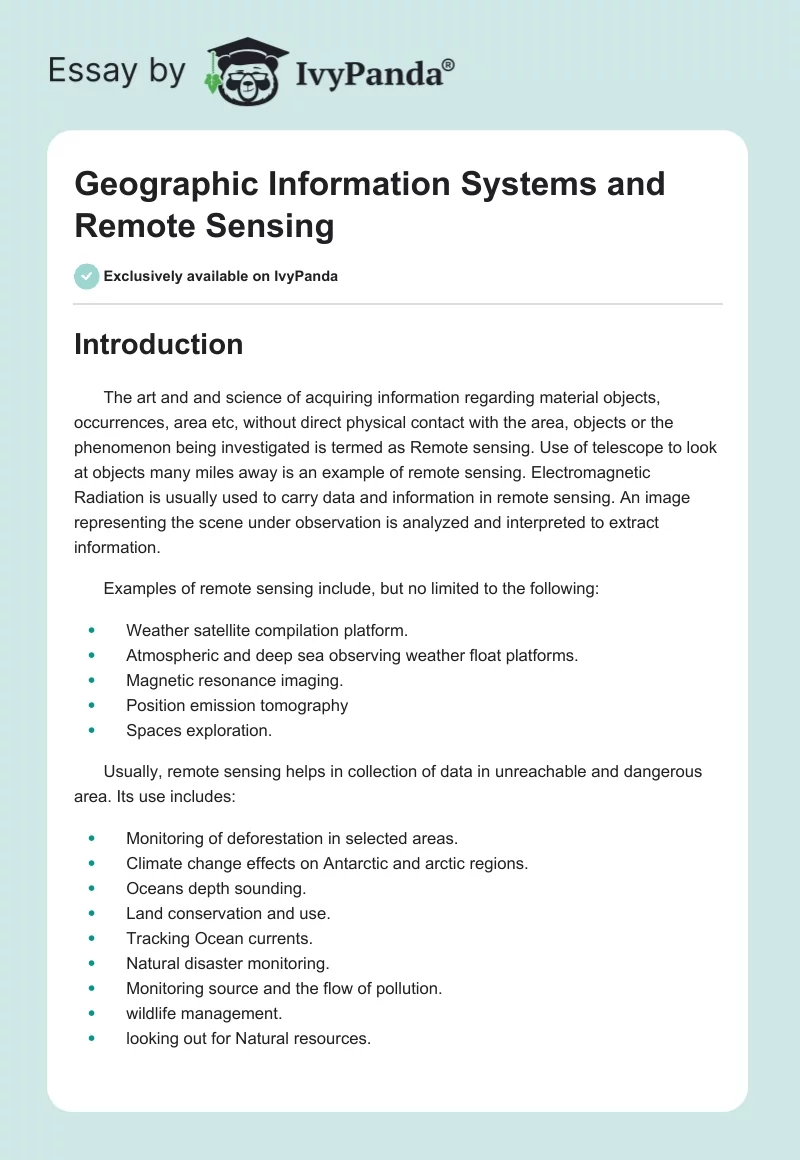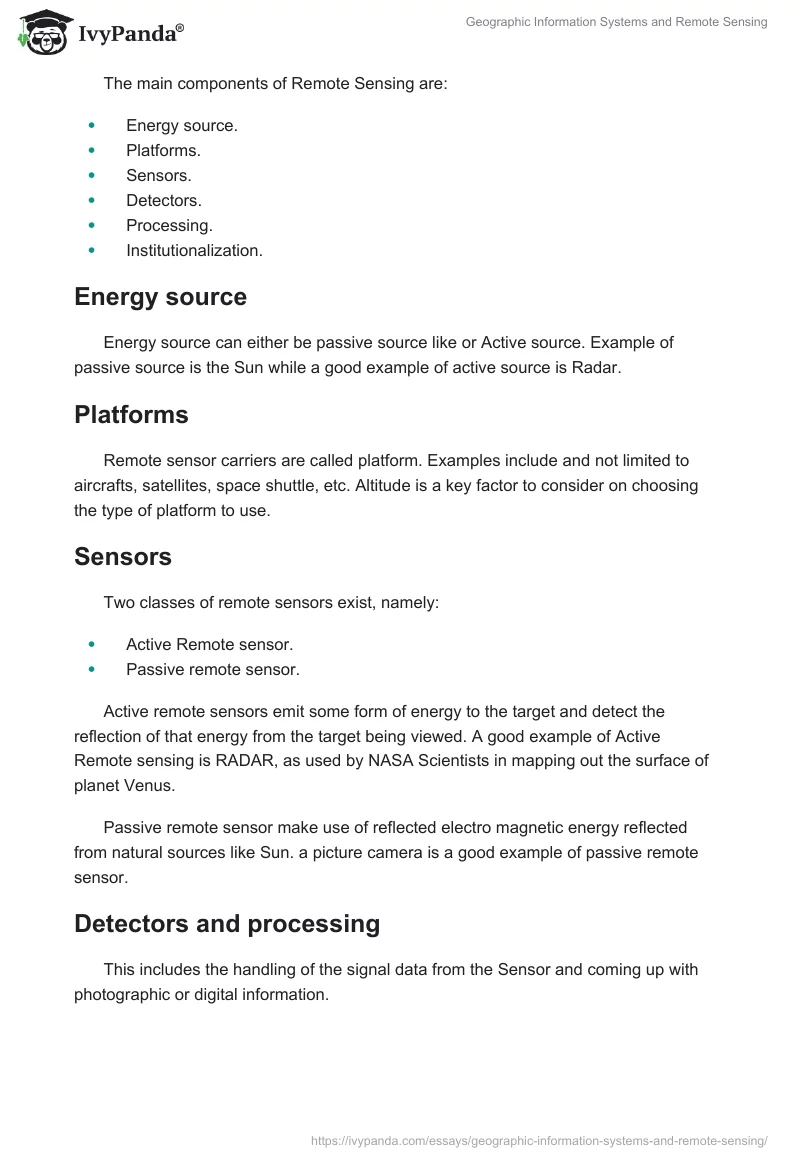Introduction
The art and and science of acquiring information regarding material objects, occurrences, area etc, without direct physical contact with the area, objects or the phenomenon being investigated is termed as Remote sensing. Use of telescope to look at objects many miles away is an example of remote sensing. Electromagnetic Radiation is usually used to carry data and information in remote sensing. An image representing the scene under observation is analyzed and interpreted to extract information.
Examples of remote sensing include, but no limited to the following:
- Weather satellite compilation platform.
- Atmospheric and deep sea observing weather float platforms.
- Magnetic resonance imaging.
- Position emission tomography
- Spaces exploration.
Usually, remote sensing helps in collection of data in unreachable and dangerous area. Its use includes:
- Monitoring of deforestation in selected areas.
- Climate change effects on Antarctic and arctic regions.
- Oceans depth sounding.
- Land conservation and use.
- Tracking Ocean currents.
- Natural disaster monitoring.
- Monitoring source and the flow of pollution.
- wildlife management.
- looking out for Natural resources.
The main components of Remote Sensing are:
- Energy source.
- Platforms.
- Sensors.
- Detectors.
- Processing.
- Institutionalization.
Energy source
Energy source can either be passive source like or Active source. Example of passive source is the Sun while a good example of active source is Radar.
Platforms
Remote sensor carriers are called platform. Examples include and not limited to aircrafts, satellites, space shuttle, etc. Altitude is a key factor to consider on choosing the type of platform to use.
Sensors
Two classes of remote sensors exist, namely:
- Active Remote sensor.
- Passive remote sensor.
Active remote sensors emit some form of energy to the target and detect the reflection of that energy from the target being viewed. A good example of Active Remote sensing is RADAR, as used by NASA Scientists in mapping out the surface of planet Venus.
Passive remote sensor make use of reflected electro magnetic energy reflected from natural sources like Sun. a picture camera is a good example of passive remote sensor.
Detectors and processing
This includes the handling of the signal data from the Sensor and coming up with photographic or digital information.
Institutilisation
This refers to the organization involved in all stages of remote sensing like universities, national and international centers etc.
In respect to wavelength regions remote sensing can be classified in, in to three types, namely:
- Visible and reflective infrared remote sensing
- Thermal infrared remote sensing.
- Microwave remote sensing.
Different Ways in Which Remote Sensing Is Carried Out
Aerial Photography
Aerial photographs are a powerful tool for earth’s environmental studies. Distinctive use of aerial photos include land survey and habitat study. Aerial photos are usually taken at a scale most people are unfamiliar with and objects are portrayed from an overhead position.
The following basic elements help in identifying objects on aerial photos: Tone, size, shape, texture, shadow, pattern and site.
Aerial photographs can either be black and white or color.
Advantages of Aerial Photography
- Aerial photos offer better vantage point
- The photo is a permanent recording.
- Has broader spectral sensitivity than the normal eye.
- It has better resolutions than ground sensing methods.
Applications of Aerial photography
The following are the major application aerial photograph
- Land use planning and mapping
- Geologic mapping
- Archaeology
- Species habitat mapping.
Integration of Aerial Photography in Geographic Information Systems
Digital imaging processing – remotely sensed data are processed digitally because of the following main reasons.
- Human beings are limited in distinguishing small differences in color. Out of 256 shades of gray used to collect data, human being can only distinguish only 8-10 shades leading to loss of lot of information. Computers on the hand can easily distinguish the 256 shades of gray. This way the data analyst can extract, compare and contrast the data with more ease and at a high speed.
- Computer generated results are usually repeatable as compared to human being interpretation which are highly subjective and hard to repeat.
- Computers are better suited in managing huge body of tedious data than human being.
Satellite Imagery
Photographs of earth and other planets made by means of satellite are termed as satellite imagery. Satelite Imagery has a history dating back to 1959 when the first satellite photo of earth was made.
Applications of Satelite photography
The major areas where satellite images are applied include but not limited to: Agriculture, Geology, Forestry, biodiversity conservation, regional planting and Education. Satellite images can either be in colors or in other spectra. Imaging Software is used to Analysis and interpretation of satellite image.
Depending on the instrument used and the altitude of satellite orbits, the resolutions of the images varies. In some cases, satellite imagery is enhanced with Aerial photography which has a higher resolution.
Disadvantages of Satellite imagery
- The earth area being so large, satellite database become so huge making image processing a time consuming activity.
- Image quality is affected depending with Weather condition and the type of sensor used.
- The public do not have free access to satellite imagery as one have to be licensed by Satellite Company to use their imagery.
- People who do not wish to have their property shown from above have brought about privacy.
Microwave Remote Sensing
In microwave remote sensing, remote sensing satellites carry active microwave sensors which emit microwave radiation which illuminate the areas being imaged. The earth surface images are formed by measuring the Microwave energy spread out by the ground back to the sensor.
Due to the fact that these satellites carry their own light emitting microwaves to light up the objects, images can be acquired day or night. Microwave have an added advantage as they can go through the clouds making it possible to acquire image even when there are cloud covers on the earth surface.
Thermal Infrared Imaging
Thermal infrared make the use of is emmited energy for illuminating as opposed to photographic infrared which make use of reflected energy.
Disadvantages of thermal scanning imagery
- The method is very expensive
- Data obtained through thermal infrared imaging have a complicated processing requirement
- Thermal infrared imaging systems are very hard to calibrate.
- Strict operational standards have to be observed when using Thermal infrared imaging systems.
- Thermal images are usually not detailed.
GIS in Remote Sensing
Geographic Information system is established in order to promote integration of remote sensing and geographic data. This way, both the graphic data and the images are stored in a digital form, easily retrieved when needed, overlaid and evaluated by using a model.
Function of GIS
- Storage and management of Geographic data and information effectively and comprehensively.
- To present geographic information according to the purpose of use.
- To analyze and evaluate geographic information effectively and comprehensively.
Reference
Jensen, J.R. (2007) Remote sensing of the environment: an Earth resource perspective, 2nd ed., Prentice Hall, UK.
Jensen, J.R. (2005) Digital Image Processing: a Remote Sensing Perspective, 3rd ed., Prentice Hall, UK.


